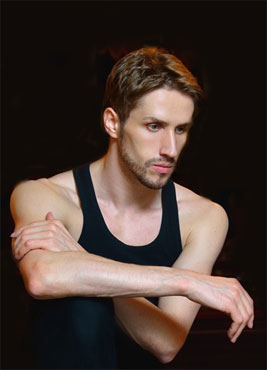Repertoire
He danced the following parts at the Saint-Petersburg M. Moussorgsky State Academic Opera and Ballet Theatre:
Espada, Basil (Don Quixote by L. Minkus, choreography by A. Gorsky);
Pas de trois, Spanish dance, Prince Siegfried (Swan Lake by P. Tchaikovsky, choreography by M. Petipa, L. Ivanov);
Nutcracker Prince (Nutcracker by P. Tchaikovsky; choreography by N. Boyarchikov);
Prince Desire (The Sleeping Beauty by P. Tchaikovsky; choreography by Marius Petipa, with the use of materials from the versions of F. Lopukhov, K. Sergeyev, P. Gusev);
Phoebus (Esmeralda by C. Pugni; version of N. Boyarchikov based on the choreography of J. Perrot and M. Petipa);
Solor (La Bayadere by L. Minkus; choreography by Marius Petipa);
Pierre (Halte de Cavalerie by I. Armsheime; choreography by Marius Petipa);
Paris, Valentin (Faust by Sh. Kallos; choreography by N. Boyarchikov);
Count Albrecht (Giselle by A. Adam; choreography by J. Coralli, J. Perrot, M. Petipa in a version by Yu. Grigorovich);
James (La Sylphide by H. Lovenskiold; choreography by A Bournonville).
At the Bolshoi Theatre the following parts were added to his repertoire:
2006
Yan (D. Shostakovich Bolt by D. Shostakovich; choreography by A. Ratmansky);
Jose (Carmen Suite by G. Bizet and R. Shchedrin; choreography by A. Alonso);
Miller (The Three-Cornered Hat by M. de Falla; choreography by L. Massine);
Fisherman (La Fille du Pharaon by C. Pugni; production by P. Lacotte, based on choreography by M. Petipa);
Tchaikovsky Pas de Deux (choreography by G. Balanchine);
Soloist (Middle Duet by Yu. Khanon; choreography by A. Ratmansky);
Pyotr (The Bright Stream by D. Shostakovich; choreography by A. Ratmansky);
2007
Boris (The Golden Age by D. Shostakovich; choreography by Yu. Grigorovich); Prince (Cinderella by S. Prokofiev; choreography by Yu. Posokhov);
Soloist (In the Upper Room by Ph. Glass; choreography by T. Tharp) — he was among the first dancers in this ballet at the Bolshoi Theatre;
Soloist (Misericordes by A. Part; choreography by C. Wheeldon);
Toreador (Don Quixote, choreography by M. Petipa, A. Gorsky in a version by A. Fadeyechev);
Birbanto (Le Corsaire by A. Adam; choreography by M. Petipa, production and new choreography by A. Ratmansky and Yu. Burlaka);
Soloist (Class Concert by A. Glazunov, A. Lyadov, A. Rubinstein, D. Shostakovich; choreography by A. Messerer);
Count Albrecht (Giselle by A. Adam; choreography by J. Coralli, J. Perrot, M. Petipa in a version by Yu. Grigorovich);
2008
James (La Sylphide by H. S. Levenskiold; choreography by A. Bournonville in a version by J. Kobborg);
Jerome (The Flames of Paris by B. Asfiev; production by A. Ratmansky with the use of choreography by V. Vainonen);
Basil (Don Quixote by L. Minkus, choreography by M. Petipa, A. Gorsky in a version by A. Fadeyechev);
Couple in Yellow (Russian Seasons by L. Desyatnikov, production by A. Ratmansky) — participated in the opening night of the ballet at the Bolshoi Theatre;
Ballet Dancer (The Bright Stream by D. Shostakovich; choreography by A. Ratmansky);
2009
Teacher (The Lesson by G. Delerue; production by F. Flindt);
Theta/Chronos (Zakharova Super Game by E. Palmieri; choreography by F. Ventriglia) — first dancer;
Crassus (Spartacus by A. Khachaturian; choreography by Yu. Grigorovich);
2010
Petrushka (Petrushka by I. Stravinsky; choreography by M. Fokine; new choreographic version by S. Vikharev);
Lead in Rubies (Part II of the ballet Jewels by I. Stravinsky; choreography by G. Balanchine);
Drosselmeyer (Nutcracker by P. Tchaikovsky; choreography by Yu. Grigorovich);
2011
Lucien (Lost Illusions by L. Desyatnikov; production by A. Ratmansky);
2012
part in Remanso (choreography by N. Duato);
Student (Anyuta by V. Gavrilin; choreography by V. Vasiliev);
2013
Bidet, Pedestrians, Waltz (Kvartira by Fleshquartet; production by M. Ek);
Pyotr Leontievich (Anyuta by V. Gavrilin; choreography by V. Vasiliev);
Pepinelli (Marco Spada by D. F. E. Auber; choreography by P. Lacotte vased on J. Mazilier’s version);
2014
Embryos (Kvartira);
M. Duval (Lady of the Camellias by F. Chopin; choreography by J. Neumeier) – first dancer of the part at the Bolshoi Teatre;
Pechorin (A Hero of Our Time by I. Demutsky, in Princess Mary part; choreography by Yu. Possokhov; director K. Serebrennikov).

 Biography
Biography